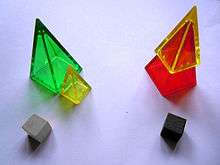Zendo (game)
 The beginning of a game of Zendo. According to the marker stones, the koan on the left follows the Master's rule, but the one on the right does not. | |
| Designer(s) | Kory Heath |
|---|---|
| Publisher(s) | Looney Labs |
| Players | 3–6 |
| Age range | All ages |
| Setup time | < 5 minutes |
| Playing time | 5–30 minutes |
| Random chance | Low |
| Skill(s) required |
Inductive reasoning Pattern recognition |
Zendo is a game of inductive logic designed by Kory Heath in which one player (the "Master") creates a rule for structures ("koans") to follow, and the other players (the "Students") try to discover it by building and studying various koans which follow or break the rule. The first student to correctly state the rule wins.
The game can be played with any set of colorful playing pieces, and has been sold with a set of 60 Icehouse pieces in red, yellow, green, and blue, 60 glass stones and a small deck of cards containing simple rules for beginners. Origami pyramids are a common choice of playing piece.
The rules were published in 2001 after more than a year of playtests and changes.[1] A boxed set of the game was released by Looney Labs at the 2003 Origins Game Fair but is now out of print. Zendo is also published in Looney Labs' Playing with Pyramids, a book of rules and strategies for a dozen popular games playable with Icehouse pieces.
Zendo can be compared to the card game Eleusis and the chess variant Penultima in which players attempt to discover inductively a secret rule thought of by one or more players (called "God" or "Nature" in Eleusis and "Spectators" in Penultima) who declare plays legal or illegal on the basis of their rules.
Gameplay
Within Zendo, most players are known as Students, who will build structures of pieces known as koans. Before play, one player (known as the Master) will invent a secret Rule, such as "a koan has the Buddha-nature if and only if it contains one or more green pieces".[2] The Master then builds two koans - one which follows the rule and one which does not. These are marked with a white and black stone respectively.
Students then take turns to build koans. After building a koan, a student may call either "Master" or "Mondo":[2]
- Master: The Master will determine whether that Student's koan follows or breaks the Rule (also stylized as: "possesses or lacks the Buddha-nature", in fitting with the game's philosophical theme[3][4]) and mark it with a white or black stone accordingly.
- Mondo: Each Student guesses whether the koan follows or breaks the rule, by holding a black or white stone in their hand. The Master marks whether the koan follows the rule, and stones are revealed simultaneously: Students who guessed correctly are awarded a Guessing Stone.[2]
At the end of their turn, a Student may spend Guessing Stones to guess the Master's Rule. If the guess is wrong, the Master may build and mark a new koan (which either fits the Master's Rule but not the Student's guess, or vice versa) to prove this. The first student to correctly state the rule wins that round and becomes the new Master.[2]
Philosophy of play
Zendo encourages inductive reasoning and scientific thinking due to the nature of the guessing process. Players are enticed to think critically while playing the game.[4]
Although it is possible to 'win' Zendo by correctly stating a rule, there are no losers. Every player benefits from observing and following play. Furthermore, Masters may 'win' as well, by choosing a challenging, yet simple Rule.[1]
Koan attributes

Pieces tend to be objects with multiple discrete distinguishing attributes; for example, Icehouse pieces, folded paper pyramids or Lego blocks. Using these, it is possible to create many different parts inside a koan. A partial list[4][1] of koan attributes is below.
- Size of pieces
- Color of pieces
- Number of pieces
- Relative orientation ("pointing at another piece/parallel to another piece") of pieces
- Groundedness (pieces supported entirely by other pieces are not "grounded") of pieces
Awards
- Zendo won the 2003 Origins Award for "Abstract Board Game".[5]
- Zendo was named one of the 2005 Mensa Select games by American Mensa.[6]
References
- 1 2 3 Heath, Kory (8 September 2004). "Zendo—Design History". Retrieved 2010-02-23.
- 1 2 3 4 http://koryheath.com/zendo/
- ↑ "Game Review: Zendo". Critical Hits. 16 Nov 2005. Retrieved 9 Sep 2015.
- 1 2 3 Petty, Mike (3 Jul 2015). "The Fun and Beauty of Game Design: An Interview with Kory Heath.". Fair Play Games. Retrieved 9 Sep 2015.
- ↑ "Origins Award Winners for 2003". ICv2. June 28, 2004. Retrieved June 8, 2015.
- ↑ Arneson, Erik. "Mensa Select Award Winners". About.com. Retrieved June 12, 2015.